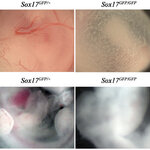Microbiology

Autopsies usually point to a cause of death but now a study of brain tissue collected from people who committed suicide may explain an underlying cause of major depression and suicide.
The international research group, led by Dr. Michael O. Poulter of Robarts Research Institute at The University of Western Ontario and Dr. Hymie Anisman of the Neuroscience Research Institute at Carleton University, says that proteins that modify DNA directly are more highly expressed in the brains of people who commit suicide, they write in Biological Psychiatry.
These proteins are involved in chemically…

"Human embryonic stem cells promise unrivalled opportunities. However, they are difficult, time-consuming and expensive to grow in the lab", says Dr. Chris Denning of Institute of Genetics, who is working on research looking at the process that turns a stem cell into a cardiomyocyte - the beating cell that makes up the heart.
The Nottingham researchers are developing a new system to monitor cardiomyocytes in real time as they differentiate from stem cells into beating heart cells. The system uses electrophysiology to record the electrical properties in a cell. The researchers hope that…

Stem cells are generally assigned to one of two categories: embryonic or adult. Some researchers say that may be an oversimplification and a new University of Michigan study states that stem cells in the developing fetus are distinct from both embryonic and adult stem cells.
Researchers note that fetal blood-forming stem cells in umbilical cord blood behave differently than adult blood-forming stem cells after transplantation into patients, which would mean that fetal stem cells comprise a separate class.
A University of Michigan team has identified the first known gene, Sox17, required for…

Scientists from two European-funded groups - EuroStemCell (European Consortium for Stem Cell Research) and ESTOOLS - are working together to call for a relaxation of current laws, particularly in Germany and Italy, in the hope that their European counterparts are able to collaborate on international projects without fear of legal reprisal.
Currently, stem cell legislation differs across Europe. Projects that are perfectly legal in Sweden and the UK could result in a three-year prison sentence in Germany. Researchers from countries with very restrictive legislation might also become liable by…

6% of the patient population in Melbourne carries a genetic abnormality implicated in thalassemia. As well as causing blood disorders and severe mental retardation, boys with ATRX mutations have genital abnormalities. Our understanding of the genetic mutations which underlie this cluster of disorders has been advanced significantly by research performed by Dr. Anthony Argentaro.
Employing nuclear magnetic resonance while at Oxford and Cambridge Universities, he solved the three-dimensional structure of part of the huge ATRX protein that carries most of the clinical mutations. By comparing the…

Carnegie Mellon University scientists have made an important discovery that aids the understanding of why HIV enters immune cells with ease. The researchers found that after HIV docks onto a host cell, it dramatically lowers the energy required for a cell membrane to bend, making it easier for the virus to infect immune cells. The finding, in press in Biophysical Journal, will provide vital data to conduct future computer simulations of HIV dynamics to help further drug discovery and prevent deadly infections.
“We found that HIV fusion peptide dramatically decreases the amount of energy…
Monkey viruses related to HIV may have swept across Africa more recently than previously thought, according to new research from The University of Arizona in Tucson.
A new family tree for African green monkeys shows that an HIV-like virus, simian immunodeficiency virus, or SIV, first infected those monkeys after the lineage split into four species. The new research reveals the split happened about 3 million years ago.
Previously, scientists thought SIV infected an ancestor of green monkeys before the lineage split, much longer ago.
The arrows on this map of Africa illustrates the UA…

Researchers from MIT have uncovered a molecular mechanism that governs the formation of fears stemming from traumatic events. The work could lead to the first drug to treat the millions of adults who suffer each year from persistent, debilitating fears - including hundreds of soldiers returning from conflict in Iraq and Afghanistan.
A study conducted by the Army in 2004 found that one in eight soldiers returning from Iraq reported symptoms of post-traumatic stress disorder (PTSD). According to the National Center for PTSD in the United States, around eight percent of the population will have…

To protect us from disease our immune system employs macrophages, cells that roam our body in search of disease-causing bacteria. With the help of long tentacle-like protrusions, macrophages can catch suspicious particles, pull them towards their cell bodies, internalise and destroy them.
Using a special microscopy technique, researchers from the European Molecular Biology Laboratory (EMBL) now for the first time tracked the dynamic behaviour of these tentacles in three dimensions. In the current online issue of PNAS they describe a molecular mechanism that likely underlies the tentacle…

A team of researchers at Umeå University in Sweden have discovered a unique mechanism by which the same signal molecule determines the formation of the both the lens of the eye and the olfactory cells of the nose.
Smell and sight are two sensory systems that are crucial to our ability to perceive the world around us. The ability to sense smells is established by the development of the olfactory mucous membrane. The ability to see is similarly dependent on the formation of the lens in the eyes.
Both the mucous membrane for smelling and the lens develop early in the fetal stage, but it has not…